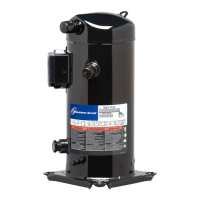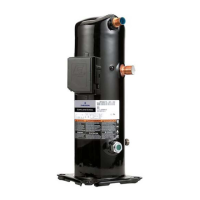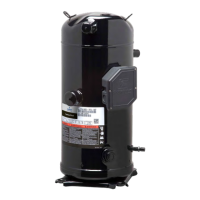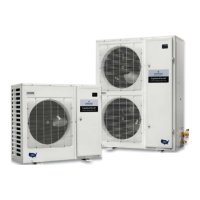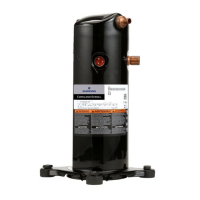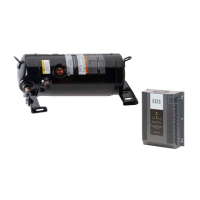C6.2.7/0302-0903/E 12
These valves could also be used to measure the operating pressures to ensure there are no excessive pressure
drops in the suction line and liquid line, which will also give an indication that the expansion device receives full bore
liquid, ensuring the system performs at its most efficiently.
Evacuating the system only on the suction side of a Scroll compressor can occasionally result in a temporary no-start
condition for the compressor. The reason for this is that the floating seal could axially seal with the scroll set, with the
higher pressure on the floating seal. Consequently, until the pressures equalize, the floating seal and scroll set can be
held tightly together.
The installation should be evacuated down to 0.3 mbar/ 0.22 Torr or lower. Subsequently, the factory holding charge
of dry air in the compressor is released to the ambient. The shut-off valves are opened and the installation, including
the compressor, are once more evacuated as described after the system has been recharged with dry nitrogen.
Highest demands are placed on the leak proof design of the installation and also on the leak testing methods. (Please
refer to EN378).
Rapid charging on the suction side of Scroll compressors can occasionally result in a temporary no-start condition for
the compressor. The reason for this is that if the flanks of the spirals happen to be in a sealed position, rapid
pressurization of the low side without opposing high side pressure can cause the spirals to seal axially. Consequently,
until the pressures eventually equalize, the spirals can be held tightly together, preventing rotation. The best way to
avoid this situation is to charge on both the high and low side simultaneously at a rate, which does not result in axial
loading of the spirals. The maximum charging rate can be determined through simple tests.
28 Unbrazing System Components
If the refrigerant charge is removed from a scroll-equipped unit by bleeding the high side only, it is sometimes
possible for the scrolls to seal, preventing pressure equalization through the compressor. This may leave the low side
shell and suction line tubing pressurized. If a brazing torch is then applied to the low side while the low side shell and
suction line contains pressure, the pressurized refrigerant and oil mixture could ignite when it escapes and contacts
the brazing flame. To prevent this occurrence, it is important to check both the high and low side with gauges before
unbrazing, or in the case of repairing a unit on an assembly line, bleed refrigerant from both the high and low side.
Instructions should be provided in appropriate product literature and assembly (line repair) areas.
29 Compressor Replacement
In the case of a motor burn, the majority of contaminated oil will be removed with the compressor. The rest of the oil is
cleaned through use of suction and liquid line filter dryers. A 100% activated alumina suction filter drier is
recommended but must be removed after 72 hours. It is highly recommended that the suction accumulator be
replaced if the system contains one. This is because the accumulator oil return orifice or screen may be plugged with
debris or may become plugged shortly after a compressor failure. This will result in starvation of oil to the replacement
compressor and a second failure.
When a single compressor or tandem is exchanged in the field, a major portion of the oil may still be in the system.
While this may not affect the reliability of the replacement compressor, the extra oil will add to rotor drag and increase
power usage.
See Section 24 for Rotalock valve, flange fittings, sight glass, and mounting bolt torques values.

